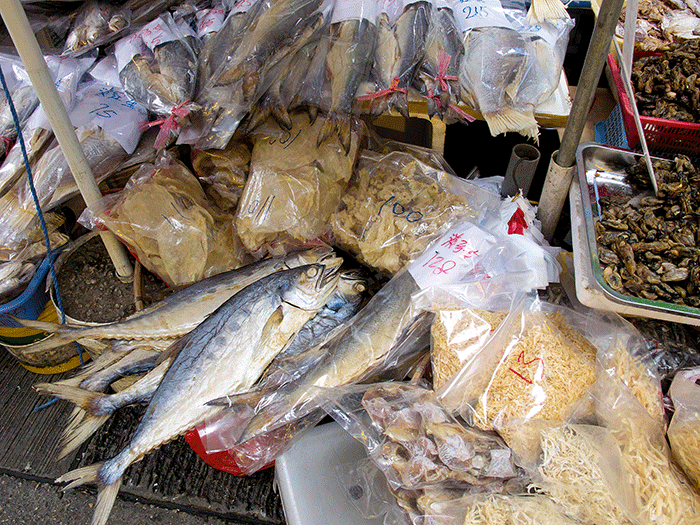The Australian industry is trialling new vacuum-drying technology that speeds up the process and could produce a new range of high-value dried seafood for export to Asia, particularly Hong Kong, China and Japan.
 The Australian industry is trialling new vacuum-drying technology that speeds up teh process and could produce a new range of high-value dried seafood for export to Asia, particularly Hong Kong, China and Japan.
The Australian industry is trialling new vacuum-drying technology that speeds up teh process and could produce a new range of high-value dried seafood for export to Asia, particularly Hong Kong, China and Japan.By Catherine Norwood
From emergency food rations provided by international aid agencies to the gourmet luxury of dried pearl meat or oysters, drying technologies have the potential to extend the reach of Australian seafood.
Of particular interest is the Asian market, where dried seafood is considered a delicacy.Traditional air-drying methods take many weeks or months of combating weather conditions and pests. Improving this process would open the door to a vast market.
The Australian industry is trialling new vacuum-drying technology on Western Australian seafood, which speeds up the process and could produce a new range of high-value dried seafood for export to Asia, targeting Hong Kong, China and Japan in particular.
The WA Fishing Industry Council (WAFIC) identified whole abalone, whole scallops and pearl meat as the three products with the greatest potential in Asia. Abalone and scallops are already well known. Dried pearl meat – the abductor muscle taken from pearl-producing oysters – is a much rarer and highly prized product.
The research is being led by Janet Howieson at Curtin University’s Centre of Excellence for Science, Seafood and Health for the Seafood Cooperative Research Centre (CRC). She says the aim is to optimise drying techniques to create final products that compare favourably with traditionally dried products available in Asia.
An initial laboratory-based trial produced vacuum-dried and freeze-dried scallops and pearl meat. The samples were well received by two focus groups of people from traditional Asian backgrounds.
Subsequent research is focusing on vacuum drying rather than the more energy-intensive freeze-drying techniques.
“We are using a pilot-sized vacuum-drying machine from Japan to assess the potential of products and to optimise the preparation of seafood to be dried, the drying times and techniques,” Janet Howieson says.
“Because the dryer operates at near-ambient temperatures – 40°C to 60°C it preserves both the protein content of the seafood and the shape.”
 Researcher Stephen Iaschi with the pilot drier used to prepare seafood product samples.
Researcher Stephen Iaschi with the pilot drier used to prepare seafood product samples. Photo: Catherine Norwood
She says it provides the ability to dry seafood more hygienically and quickly. Rather than taking months, the trial dryer took only six hours at 48°C to produce about 40 kilograms of dried scallops and pearl meat at the target six per cent moisture content.
Using drying technologies to develop new uses for fisheries waste products has also been part of the research Janet Howieson is overseeing. “Up to 50 per cent of a fish can be discarded during processing, including the heads, frames and guts,” she says.
“We have been trialling new drying technology to develop fishmeal and oil that could be used in new products for human consumption.”
The Japanese vacuum dryer uses an agitation process that breaks down solid fish inputs into fishmeal as it dries. Water and soluble elements are extracted and oil is separated. Waste seafood products trialled in the vacuum dryer include Atlantic Salmon frames, Australian Salmon frames, Barramundi frames, prawn shells, shark cartilage, Escolar and octopus heads.
“One of the most likely products we could develop from this is some kind of fish-fortified biscuit,” Janet Howieson says.
“We are investigating opportunities for an emergency or supplementary ration as part of humanitarian aid supplies for developing countries.”
Other potential uses include dried sardine meal to produce dashi fish stock, a fundamental ingredient in Japanese and Korean cuisine, and dried sardines as a supplement in poultry foods to increase omega-3 levels in eggs.
Oils extracted from the fish frames are a potential ingredient in omega-3 fish oil supplements for human consumption and fishmeal could also be used in pet food.
Jayne Gallagher, program manager of product and market development at the Australian Seafood CRC, says WAFIC was keen to trial drying technology for its members.
“We have funded the work to determine the product quality, safety, nutritional composition, sensory characteristics and shelf life of the trial products,” she says.
“Now that the work has been done and we have identified some opportunities, we are interested to work with companies to determine if those opportunities can be scaled up commercially.
“The waste utilisation opportunity is particularly interesting because, if it is commercially viable, it could add significant value to our seafood industry by using products that would normally be discarded.”
More information
Janet Howieson, 08 9266 2034, 0423 840 957
j.howieson@curtin.edu.au





